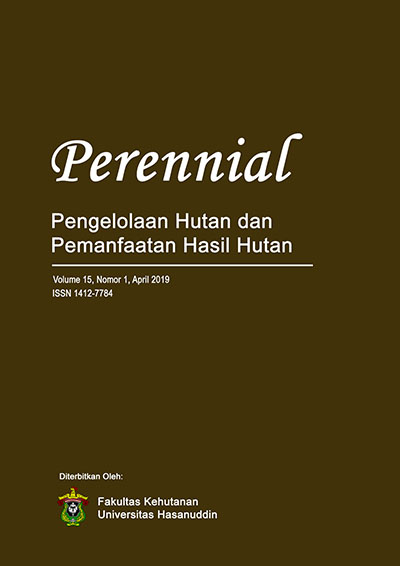POTENSI DAN PEMANFAATAN BAMBU TALI (Gigantochloa apus) DI DESA LEU KECAMATAN BOLO KABUPATEN BIMA
DOI:
https://doi.org/10.24259/perennial.v15i1.6790Kata Kunci:
Potential, Utiization, Gigantochloa apus, Leu VillageAbstrak
Non-timber forest products are a wealth of natural resources that provide many benefits for the needs of the community around the forest. This study aims to determine the potential and utilization of bamboo in Leu Village in Bolo District, Bima Regency. The usefulness of this research is expected to be an information material for efforts to empower and utilize bamboo optimally and alternatively for the community. This research was conducted in March-April 2018 in Leu Village, Bolo District, Bima Regency. The data collected in this study consists of primary data and secondary data. Primary data is obtained by observing and recording in the field, as well as interviewing the community / respondents who use bamboo plants. Secondary data is collected through library studies sourced from books, journals, and data from relevant agencies. Leu village has the potential of rope bamboo stands (Gigantochloa apus) in Leu Village, Bolo District, Bima Regency, which is relatively low at 3843 stems per ha, with 61 clumps of clumps with an average of 63 clumps. The average bamboo harvested per year is still relatively small at 11.25% of the potential of old bamboo. The form of utilization of bamboo by farmers in addition to being sold is generally used as building materials, handicrafts, and as fences.Unduhan
Referensi
Dransfield, S., & Widjaja, E. (1995). Plat Resources of Sounth East Asia (PERSEO) No.7: Bamboos. Leiden, NLD: Bckhuys Publisher.
Dinas Kehutanan Provinsi Jawa Barat. (2008). Bambu Untuk Menghadapi Pemasaran Global. Jawa Barat: Dinas Kehutanan Provinsi Jawa Barat.
Departemen Kehutanan dan Perkebunan. (2004). Panduan Kehutanan Indonesia, Badan Penelitian dan Pengembangan Kehutanan dan Perkebunan. Jakarta: Departemen Kehutanan dan Perkebunan.
Hanim A. R., A. Zaidom, F. Abood, and U.M.K. Anwar. (2010). Adhesion and Boncing Characteristics of Preservatives-Treated Bamboo (Gigantochloa scortechinii) Laminates. Journal of Applied Sciences, 10 (14): 1435-1441.
ITIS. (2015). Gigantochloa apus. Diperoleh dari https://www.itis.gov/servlet/SingleRpt/SingleRpt?search_topic=TSN&search_value=506617#null, pada 7 juni 2018.
Muin, M., Suhasman, Oka, N.P., Putranto, B., Baharuddin, & Millang, S. (2006). Pengembangan Potensi dan Pemanfaatan Bambu Bebagai Bahan Baku Konstruksi dan Industri di Sulawesi Selatan. Badan Penelitian dan Pengembangan Daerah Makassar. 73p
Peraturan Menteri Kehutanan Nomor 35/Menhut II/2007 tentang Hasil Hutan Bukan Kayu.
Supriatna, N., & Kosasih, E. (2014). Bambu Tali (Gigantochloa apus Kurz). Informasi Singkat Benih, No. 176, Maret 2014. Direktorat Perbenihan Tanaman Hutan.
Rathaur, A.K. (2013). Bambusa arundinacea (vanshlochan) : An Overview. Internasional Journal of Research in Pharmacology and Pharmacotherapeutics, 2 (1) : 248-255.
Undang Undang Nomor 41 Tahun 1999 tentang Kehutanan.



